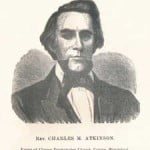Who Was That Man?
A graduate of the school, he later served for twenty-four years as a director of the Princeton Theological Seminary. But history remembers the man primarily for a series of letters that he wrote under a pseudonym. Indeed, a fair amount of his published work dealt with the Roman Catholic Church, in which he had been raised in Ireland.
Nicholas Murray was born on Christmas day in 1802, in Ballinasloe, County Galway, Ireland. He emigrated to the United States in 1818, at the age of 16, serving as a apprentice printer at Harpers in New York City, to support himself. It was during this time that he came under conviction of his sins, responded to the Gospel, and left the Roman Catholic Church. In particular, it was a sermon delivered by the Rev. John Mitchell Mason that the Lord used to bring young Murray to saving faith. Subsequently he sat under the preaching of the Rev. Gardiner Spring for a year and a half. In time he was able to graduate from college and then at Princeton prepared for the ministry. As pastor of the First Presbyterian Church in Elizabeth, New Jersey, he became a prominent figure in the Old School wing of the Presbyterian Church in the U.S.A., even serving as Moderator of the Sixty-first General Assembly, in 1849.
For several years Rev. Murray had considered a project of writing a series of letters, presenting his own experience in the Roman Catholic Church and how he was led to leave it. Friends encouraged him in this effort, and eventually the letters began to be published on the pages of The New York Observer, under the pseudonym of Kirwan. The actual Kirwan had been an Anglican Dean and like Rev. Murray, had himself once been a Roman Catholic. Murray probably took up the pseudonym out of respect for this Anglican preacher.
The first series consisted of twelve letters, published in serial fashion between February and May of 1847. These were quickly gathered up as a book and published, with more than ten thousand copies sold in the first edition. Another edition soon followed, then the work was translated into German, and eventually there were more than a hundred thousand copies in circulation. Few publications of that day exceeded these numbers. As Murray’s biographer stated, “It is certainly safe and just to say that no writings on the Roman Catholic question have excited so much attention since the Reformation, or have been so widely read by the masses of the people.”
A second series of letters began to appear in newspapers in October of 1847. This second series, less popular among Protestants, was actually more effective among Roman Catholics. Both series had been addressed to the Roman Catholic bishop of New York, the Rev. John Hughes, though Hughes ignored the appearance of the first series, and only upon publication of the second series did Bishop Hughes compose any response. Rev. Murray continued to write on this subject until about 1852. The Rev. Nicholas Murray died on February 4, 1861, and it was on March 31, 1861 that the Rev. James Baird brought a memorial address in his memory. A large biographical memoir was issued the following year by the Rev. Samuel Irenaeus Prime.
Words to Live By:
The Lord brought this young man across an ocean in order to save him. No obstacle is too great for our God. The Lord works sovereignly, where and when He will, extending His grace and mercy to the least of men and to the greatest of sinners. He raises up the most unassumingly and unlikely, to do great works for His glory. Only in eternity will it be revealed the extent to which the Lord has used each of His children in extending His kingdom.
For Further Study:
Murray, Rev. Nicholas, Letters to the Rt. Rev. John Hughes, Roman Catholic bishop of New York (1851).
Baird, Rev. James, A Discourse delivered in the First Presbyterian Church, Carleton, City of St. John, N.B., on Sabbath, 31st March, 1861: In Memory of the late Rev. Nicholas Murray, D.D., author of the “Kirwan Letters” &c., who opened the above church nearly four years ago.
Prime, Samuel Irenaeus, Memoirs of the Rev. Nicholas Murray, D.D. (“Kirwan”).

